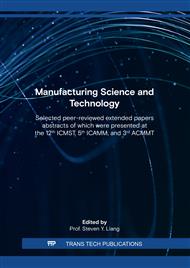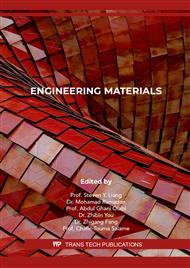[1]
Li H, Eddaoudi M, Okeeffe M. et al. Design and synthesis of an exceptionally stable and highly porous metal-organic framework[J]. Nature ,1999,402 (6759) 276-279.
DOI: 10.1038/46248
Google Scholar
[2]
Hu Z, Deibert B J, Li J. Luminescent metal-organic frameworks for chemical sensing and explosive detection[J]. Chemcial Society Reviews. 2014,43 (16): 5815-5840.
DOI: 10.1039/c4cs00010b
Google Scholar
[3]
Gandara F, Furukawa H, Lee S, et al. High methane storage capacity in aluminum metal-organic frameworks[J]. Journal of the American Chemical Society, 2014, 136 (14) 5271-5274.
DOI: 10.1021/ja501606h
Google Scholar
[4]
Flaig R W, Popp T, Fracaroli A M, et al. The chemistry of CO2 capture in an amine-functionalized metal-organic framework under dry and humid conditions[J]. Journal of the American Chemical Society, 2017, 139(35): 12125-12128.
DOI: 10.1021/jacs.7b06382
Google Scholar
[5]
Zhao X, Bu X, Nguyen E T, et al. Multivariable modular design of pore space partition[J]. Journal of the American Chemical Society, 2016, 138(46):15102-15105.
DOI: 10.1021/jacs.6b07901
Google Scholar
[6]
Liang C, Zhang X, Feng P, et al. ZIF-67 derived hollow cobalt sulfide as superior adsorbent for effective adsorption removal of ciprofloxacin antibiotics[J]. Chemical Engineering Journal, 2018,344: 95-104.
DOI: 10.1016/j.cej.2018.03.064
Google Scholar
[7]
Medishetty R, Nalla V, Nemec L, et al. A new class of lasing materials: intrinsic stimulated emission from nonlinear optically active metal-organic frameworks[J]. Advanced Materials, 2017, 29(17):1605637.1-1605637.7.
DOI: 10.1002/adma.201605637
Google Scholar
[8]
Zhu M, Hao Z, Song M, et al. A new type of double-chain based 3D lanthanide(III) metal-organic framework demonstrating proton conduction and tunable emission[J]. Chemical communications-royal society of chemistry,2014,50:19.
DOI: 10.1039/c3cc48764d
Google Scholar
[9]
Nguyen C V, Liao Y T, Kang T C, et al. A metal-free, high nitrogen-doped nanoporous graphitic carbon catalyst for an effective aerobic HMF-to-FDCA conversion[J]. Green Chemistry, 2016,18:5957-5961.
DOI: 10.1039/c6gc02118b
Google Scholar
[10]
Fan S, Dong W, Huang X, et al. In situ-induced synthesis of magnetic Cu-CuFe2O4@HKUST-1 heterostructures with enhanced catalytic performance for selective aerobic benzylic C-H oxidation[J]. Acs Catalysis, 2016, 7(1):243-249.
DOI: 10.1021/acscatal.6b02614.s001
Google Scholar
[11]
Chen Q, Li S, Liu Y, et al. Size-controllable Fe-N/C single-atom nanozyme with exceptional oxidase-like activity for sensitive detection of alkaline phosphatase[J]. Sensors and Actuators B: Chemical,2019,305:127511.
DOI: 10.1016/j.snb.2019.127511
Google Scholar
[12]
Li S Q, Liu, H X, Chai, Y M, et al. Recent advances in the construction and analytical applications of metal-organic frameworks-based nanozymes[J]. Trac Trends in Analytical Chemistry, 2018, 105 :391-403.
DOI: 10.1016/j.trac.2018.06.001
Google Scholar
[13]
Chen Q, Zhang X, Li S, et al. MOF-derived Co3O4@Co-Fe oxide double-shelled nanocages as multi- functional specific peroxidase-like nanozyme catalysts for chemo/biosensing and dye degradation[J]. Chemical Engineering Journal, 2020, 395:125130.
DOI: 10.1016/j.cej.2020.125130
Google Scholar
[14]
Zhuang Y X, Zhang X D, Chen Q M, et al. Co3O4/CuO hollow nanocage hybrids with high oxidase-like activit.
Google Scholar
[15]
Rocca J D, Liu D, Lin W. Nanoscale metaleorganic frameworks for biomedical imaging and drug delivery[J]. Accounts of Chemical Research, 2011, 44(10):957-968.
DOI: 10.1021/ar200028a
Google Scholar
[16]
Horcajada P, Gref R, Baati T, et al. Metal organic frameworks in biomedicine[J]. Chemical reviews, 2012, 112(2):1232-1268.
DOI: 10.1021/cr200256v
Google Scholar
[17]
Li J, Wang L, Liu Y Q, et al. The research trends of metal-organic frameworks in environmental science: a review based on bibliometric analysis[J]. Environmental Science and Pollution Research ,2020,27(16):19265–19284.
DOI: 10.1007/s11356-020-08241-1
Google Scholar
[18]
Rosi N L. Hydrogen storage in microporous metal-organic frameworks[J]. Science, 2003, 300(5622):1127-1129.
DOI: 10.1126/science.1083440
Google Scholar
[19]
Murray L J, Dincă M L, Jeffrey R. Hydrogen storage in metal–organic frameworks[J]. Chemical Society Reviews, 2009, 38(5):1294-1314.
DOI: 10.1039/b802256a
Google Scholar
[20]
Park K. S, Ni Z, Cote A, et al, et al. Exceptional chemical and thermal stability of zeolitic imidazolate frameworks[J]. Proceedings of the National Academy of Sciences of the United States of America, 2018, 103(27):10186–10191.
DOI: 10.1073/pnas.0602439103
Google Scholar
[21]
Rankin R B, Liu J, Kulkarni, A D, et al. Adsorption and diffusion of light gases in ZIF-68 and ZIF-70: A Simulation Study[J]. The Journal of Physical Chemistry C, 2009, 113(39):16906-16914.
DOI: 10.1021/jp903735m
Google Scholar
[22]
Gérard F, Christian S, Caroline M, et al. A Hybrid Solid with Giant Pores Prepared by a Combination of Targeted Chemistry, Simulation, and Powder Diffraction[J]. Angewandte Chemie International Edition, 2004, 43(46):6296–6301.
DOI: 10.1002/anie.200460592
Google Scholar
[23]
Wang Y L, Qiu X Z, Li Y Y, et al. Synthesis of a Molecularly Imprinted Polymer on NH2-MIL-101(Cr) for Specific Recognition of Diclofenac Sodium[J]. Journal of Nanoscience and Nanotechnology, 2020,20(3):1807–1813.
DOI: 10.1166/jnn.2020.17352
Google Scholar
[24]
Ma S, Zhou H C. A Metal−Organic Framework with Entatic Metal Centers Exhibiting High Gas Adsorption Affinity[J]. Journal of the American Chemical Society, 2006, 128(36):11734-11735.
DOI: 10.1021/ja063538z
Google Scholar
[25]
Ma S, Sun D, Simmons J M, et al. Metal-organic framework from an anthracene derivative containing nanoscopic cages exhibiting high methane uptake[J]. Journal of the American Chemical Society, 2008, 130(3):1012-1016.
DOI: 10.1021/ja0771639
Google Scholar
[26]
Puchberger M, Kogler F R, Jupa M, et al. Can the Clusters Zr6O4(OH)4(OOCR)12 and [Zr6O4(OH)4(OOCR)12]2 Be Converted into Each Other? [J]. Berichte Der Deutschen Chemischen Gesellschaft,2006,16(16):3283-3293.
DOI: 10.1002/ejic.200600348
Google Scholar
[27]
Cavka J H,Jakobsen S O, Olsbye U, et al. A New Zirconium Inorganic Building Brick Forming Metal Organic Frameworks with Exceptional Stability[J]. Journl of American Chemical Society,2008,130(42):13850-13851.
DOI: 10.1021/ja8057953
Google Scholar
[28]
Tanaka D,Nakagawa K,Higuchi M, et al. Kinetic Gate‐Opening Process in a Flexible Porous Coordination Polymer[J]. Angewandte Chemie International Edition.2008, 47(21):3914-3918.
DOI: 10.1002/anie.200705822
Google Scholar
[29]
Xiang H, Carter J H, Tang C C, et al. C2H4 and C2H6 adsorption-induced structural variation of pillared-layer CPL-2 MOF: A combined experimental and Monte Carlo simulation study[J]. Chemical Engineering Science, 2020, 218:115566.
DOI: 10.1016/j.ces.2020.115566
Google Scholar
[30]
Li J J, Wang C C, Guo, J, et al. Two zigzag chain-like lanthanide(III) coordination polymers based on the rigid 1,3-adamantanedicarboxylic acid ligand: Crystal structure, luminescence and magnetic properties[J]. Polyhedron, 2017,126:17–22.
DOI: 10.1016/j.poly.2017.01.010
Google Scholar
[31]
Eddaoudi M,Kim J,Rosi N,et al. Systematic design of pore size and functionality in isoreticular MOFs and their application in methane storage[J]. Science, 2002, 295(5554):469-472.
DOI: 10.1126/science.1067208
Google Scholar
[32]
Vakili R, Xu S, Al-Janabi N, et al. Microwave-assisted synthesis of zirconium-based metal organic frameworks (MOFs): Optimization and gas adsorption[J]. Microporous and Mesoporous Materials, 2018,260:45-53.
DOI: 10.1016/j.micromeso.2017.10.028
Google Scholar
[33]
Cho H Y, Yang D A, Kim J, et al. CO2 adsorption and catalytic application of Co-MOF-74 synthesized by microwave heating[J]. Catalysis Today, 2012, 185(1):35-40.
DOI: 10.1016/j.cattod.2011.08.019
Google Scholar
[34]
Užarević K, Wang T C, Moon S Y, et al. Mechanochemical and Solvent-free Assembly of Zirconium-Based Metal-organic Frameworks[J]. Chemical Communications,2016, 52(10):2133-2136.
DOI: 10.1039/c5cc08972g
Google Scholar
[35]
Pichon A,Lazuen-Garay A,James S L. Solvent-free synthesis of a microporous metal–organic framework[J]. Cryst Eng Comm,2006, 8(3):211–214.
DOI: 10.1039/b513750k
Google Scholar
[36]
Seoane B, Zamaro J M, Tellez C, et al. Sonocrystallization of zeolitic imidazolate frameworks (ZIF-7, ZIF-8, ZIF-11 and ZIF-20)[J]. CrystEngComm, 2012, 14(9):3103-3107.
DOI: 10.1039/c2ce06382d
Google Scholar
[37]
Jin H B, Suslick K S. Applications of ultrasound to the synthesis of nanostructured materials[J]. Advanced Materials, 2010, 22(10):1039-1059.
DOI: 10.1002/adma.200904093
Google Scholar
[38]
Li Y S, Bux H, Feldhof F A, et al. Controllable Synthesis of Metal-Organic Frameworks: From MOF Nanorods to Oriented MOF Membranes[J]. Advanced Materials, 2010, 22(30):3322-3326.
DOI: 10.1002/adma.201000857
Google Scholar
[39]
Mehta J P, Tian T, Zeng Z, et al. Sol–Gel Synthesis of Robust Metal–Organic Frameworks for Nanoparticle Encapsulation[J]. Advanced Functional Materials, (2018).
DOI: 10.1002/adfm.201705588
Google Scholar
[40]
Chen Y, Jiang J. A bio-metal-organic framework for highly selective CO2 capture: A molecular simulation study [J]. Chemsuschem, 2010, 3(8):982-988.
DOI: 10.1002/cssc.201000080
Google Scholar
[41]
Calero S, Gómez-Álvarez P. Insights into the Adsorption of Water and Small Alcohols on the Open-Metal Sites of Cu–BTC via Molecular Simulation[J]. Journal of Physical Chemistry C, 2015, 119(1):467–472.
DOI: 10.1021/jp510429w
Google Scholar
[42]
Yang Q, Zhong C. Molecular simulation of carbon dioxide/methane/hydrogen mixture adsorption in metal-organic frameworks[J]. Journal of Physical Chemistry B, 2006, 110(36):17776-17783.
DOI: 10.1021/jp062723w
Google Scholar
[43]
Keskin S. Sholl D S. Screening Metal-Organic Framework Materials for Membrane-based Methane/Carbon Dioxide Separations[J]. Journal of Physical Chemistry C, 2007,111(38), 14055–14059. l.
DOI: 10.1021/jp075290l
Google Scholar
[44]
Rodrigues M A, Souza R J,Souza C E, et al. Nanostructured membranes containing UiO-66 (Zr) and MIL-101 (Cr) for O2/N2 and CO2/N2 separation[J]. Separation and Purification Technology, Separation & Purification Technology, 2018,192:491-500.
DOI: 10.1016/j.seppur.2017.10.024
Google Scholar
[45]
Tchalala M R, Bhatt P M, Chappanda K N, et al. Fluorinated MOF platform for selective removal and sensing of SO2 from flue gas and air[J]. Nature Communications, 2019,10(1):1328.
DOI: 10.1038/s41467-019-09157-2
Google Scholar
[46]
Li Z, Liao F, Jiang F, et al. Capture of H2S and SO2 from trace sulfur containing gas mixture by functionalized UiO-66(Zr) materials: A molecular simulation study[J]. Fluid Phase Equilibria, 2016,427:259–267.
DOI: 10.1016/j.fluid.2016.07.020
Google Scholar
[47]
Blake A J, Lewis W, et al. Modifying Cage Structures in Metal–Organic Polyhedral Frameworks for H2 Storage[J]. Chemistry, 2011,17(40), 11162–11170.
DOI: 10.1002/chem.201101341
Google Scholar
[48]
Li Y W, Yang R T. Significantly Enhanced Hydrogen Storage in Metal−Organic Frameworks via Spillover[J]. Journal of the American Chemical Society, 2006,128(3): 726–727.
DOI: 10.1021/ja056831s
Google Scholar
[49]
Li B, Wen H M, Wang H, et al. A Porous Metal-Organic Framework with Dynamic Pyrimidine Groups Exhibiting Record High Methane Storage Working Capacity[J]. Journal of the American Chemical Society, 2014, 136(17):6207-6210.
DOI: 10.1021/ja501810r
Google Scholar
[50]
Mason J A, Oktawiec J, Taylor M K, et al. Methane storage in flexible metal-organic frameworks with intrinsic thermal management[J]. Nature, 2015,527:357-361.
DOI: 10.1038/nature15732
Google Scholar
[51]
Guo J, Hanif A, Shang J, et al. PAA@ZIF-8 incorporated nanofibrous membrane for high-efficiency PM2.5capture[J]. Chemical Engineering Journal, 2020,405: 126584.
DOI: 10.1016/j.cej.2020.126584
Google Scholar
[52]
MA S, ZHANG M, NIE J, et al. Design of double-component metal–organic framework air filters with PM2.5 capture, gas adsorption and antibacterial capacities[J]. Carbohydrate Polymers, 2018, 203:415-422.
DOI: 10.1016/j.carbpol.2018.09.039
Google Scholar
[53]
Wang Z, Zhang Y, Ma Xi Y, et al. Polymer/MOF-derived multilayer fibrous membranes for moisture-wicking and efficient capturing both fine and ultrafine airborne particles[J]. Separation and Purification Technology, 2020,235(C):116183-11.
DOI: 10.1016/j.seppur.2019.116183
Google Scholar
[54]
Hu Min, Yin L, Nicholas L, et al. Zeolitic-imidazolate-framework filled hierarchical porous nanofiber membrane for air cleaning[J]. Journal of Membrane Science, 2020, 594:117467-117467.
DOI: 10.1016/j.memsci.2019.117467
Google Scholar
[55]
Chen Y, Zhang S, Cao S, et al. Roll-to-Roll Production of Metal-Organic Framework Coatings for Particulate Matter Removal[J]. Advanced Materials, 2017,29(15): 1606221.
DOI: 10.1002/adma.201606221
Google Scholar



